JVC SL42B-C User Manual
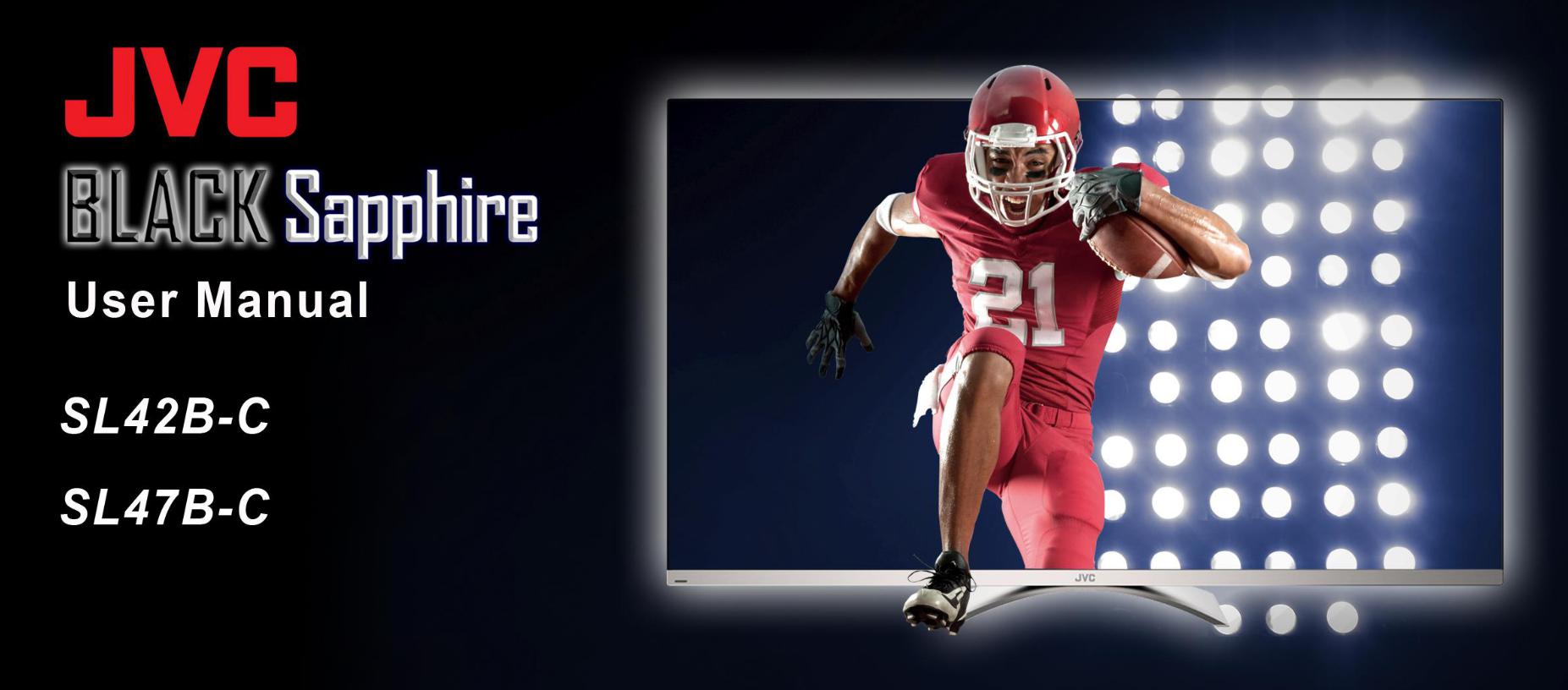
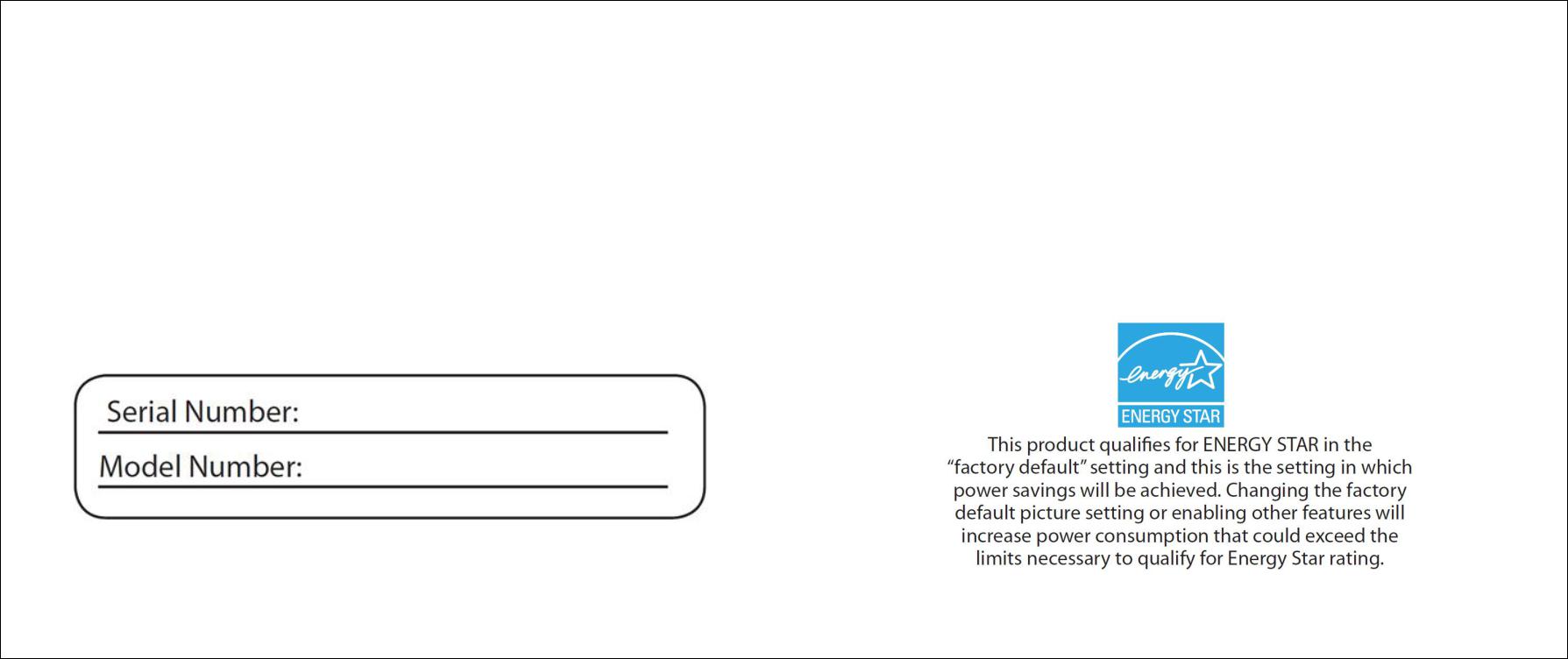
Regulatory Statement
Welcome to the JVC family of customers. We hope that you will have many years of enjoyment from your new JVC Smart E-LED HDTV. To get the most out of your JVC Smart E-LED HDTV, read these instructions before making any adjustments, and retain them for future reference.
For assistance, call the JVC Customer Support and Service Center at 1- 855-868-1928 or visit our website at http://go.jvc.com/HDTVSupport/.
We recommend that you register your JVC Smart E-LED HDTV either at our website at http://go.jvc.com/HDTVSupport/ or fill out and mail the Product Registration Card on the back of the Quick Start Guide.
Retain your purchase receipt and write down the model and serial number located at the back of your HDTV for easy reference when obtaining service support.
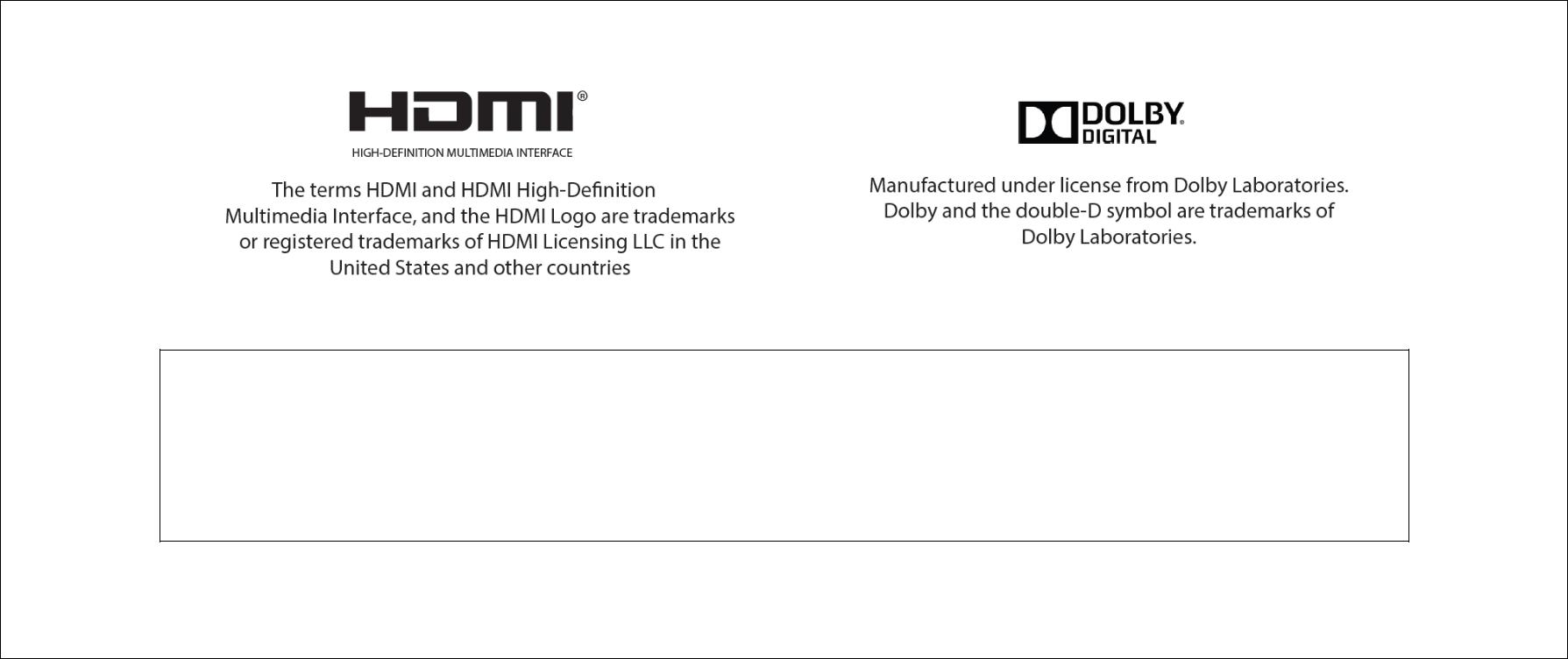
Regulatory Statement
THE TRADEMARKS SHOWN HEREIN ARE THE PROPERTY OF THEIR RESPECTIVE OWNERS;
IMAGES USED ARE FOR ILLUSTRATION PURPOSES ONLY. JVC, THE JVC LOGO, AND OTHER JVC TRADEMARKS ARE THE INTELLECTUAL PROPERTY OF JVC KENWOOD CORPORATION.
PRODUCT SPECIFICATIONS ARE SUBJECT TO CHANGE WITHOUT NOTICE.
COPYRIGHT 2012 AmTRAN Video Corporation. ALL RIGHTS RESERVED
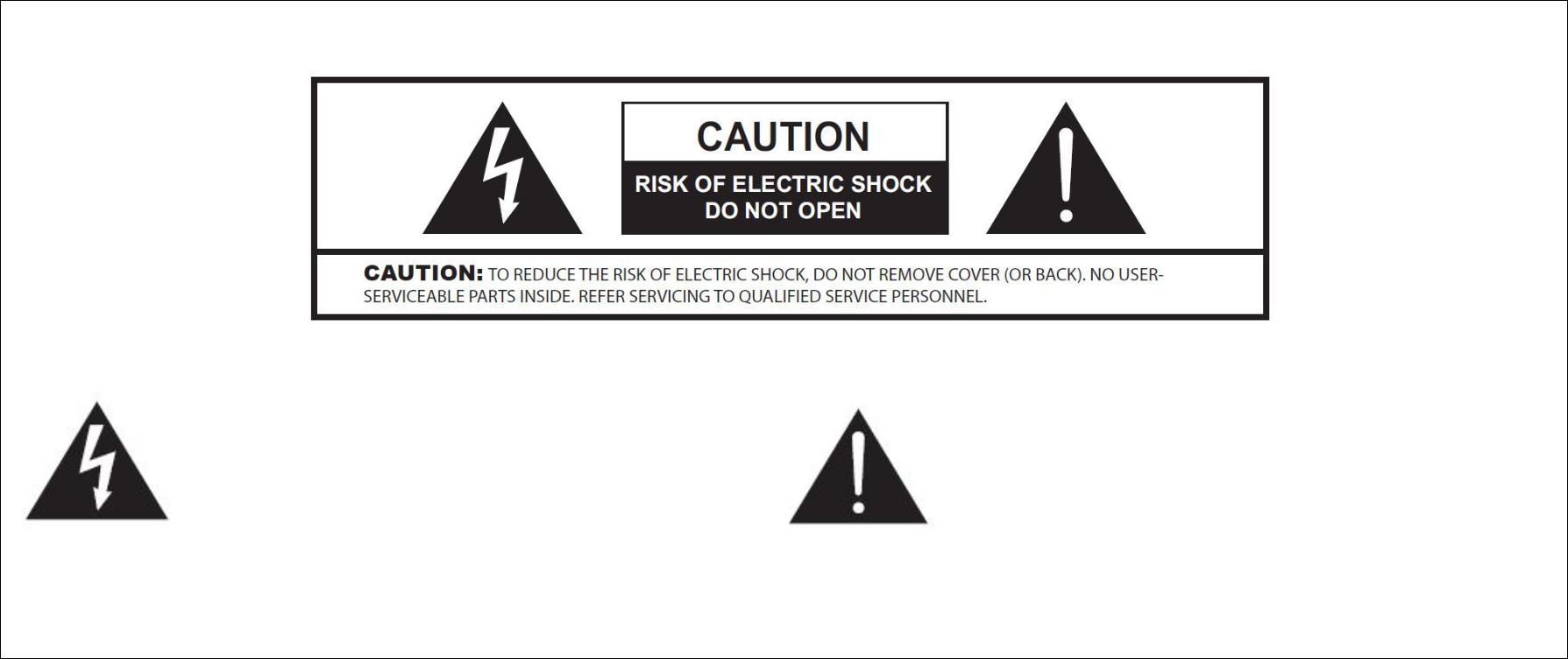
Regulatory Statement
The lightning flash with arrowhead symbol, within an equilateral triangle, is intended to alert the user to the presence of uninsulated dangerous voltage with the product’s enclosure that may be of sufficient magnitude to constitute a risk of electric shock.
The exclamation point within an equilateral triangle is intended to alert the user to the presence of important operating and maintenance (servicing) instructions in the literature accompanying the appliance.
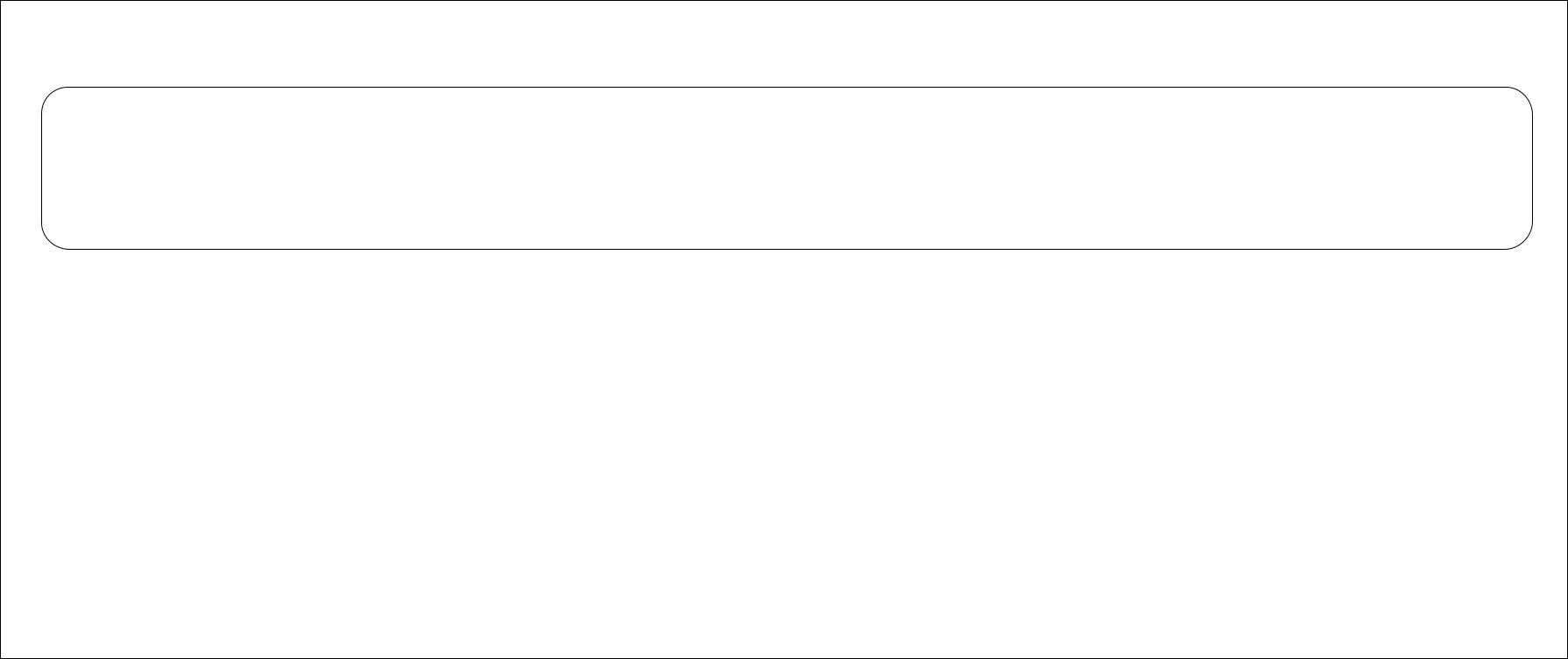
Regulatory Statement
WARNING: TO PREVENT FIRE OR SHOCK HAZARD, DO NOT EXPOSE THIS APPLICANCE TO RAIN OR MOISTURE. TO PREVENT THE SPREAD OF FIRE, KEEP CANDLES OR OPEN FLAMES AWAY FROM THIS PRODUCT AT ALL TIMES.
CAUTION: TO PREVENT ELECTRIC SHOCK, DO NOT USE THIS POLARIZED PLUG WITH AN EXTENSION CORD, RECEPTACLE, OR OTHER OUTLET UNLESS THE BLADES CAN BE FULLY INSERTED TO PREVENT BLADE EXPOSURE.
WARNING: This device complies with Part 15 of the FCC Rules. Operation is subject to the following two conditions: (1) this device may not cause harmful interference, and (2) this device must accept any interference received, including interference that may cause undesired operation. Note: This equipment has been tested and found to comply with the limits for a Class B digital device, pursuant to Part 15 of the FCC Rules. These limits are designed to provide reasonable protection against harmful interference in a residential installation. This equipment generates, uses, and can radiate radio frequency energy and, if not installed and used in accordance with the instructions, may cause harmful interference to radio communications.
However, there is no guarantee that interference will not occur in a particular installation. If this equipment does cause harmful interference to radio or television reception, which can be determined by turning the equipment off and on, the user is encouraged to try to correct the interference by one or more of the following measures:
-Reorient or relocate the receiving antenna.
-Increase the separation between the equipment and receiver.
-Connect the equipment into an outlet on a circuit different from that to which the receiver is connected

|
Regulatory Statement |
|
- Consult the dealer or an experienced radio/TV technician for help. |
CAUTION: |
Changes or modifications not expressly approved by the party responsible for compliance with the FCC Rules could void the user’s |
|
authority to operate this equipment. |
Responsible Party: AmTRAN Video Corporation
Address: 9 Goddard, Irvine, CA 92618, USA
Telephone No; 949-336 6633
Required Marking Location
The rating sheet and the safety caution are on the rear of the unit.

Important Safety Information
1)Read these instructions.
2)Heed all warnings.
3)Follow all instructions.
4)Do not use this device near water.
5)Clean only with dry cloth.
6)Do not block any ventilation openings. Install in accordance with manufacturer’s instructions.
7)Do not install near any heat sources such as radiators, heat registers, stoves, or other heat-generation devices.
8)Do not defeat the safety purpose of the polarized or grounding-type plug. A polarized plug has two blades with one wider than the other. A grounding-type plug has two blades and a third grounding prong. The wide blade or the third prong is provided for your safety. If the provided plug does not fit into your outlet, consult an electrician for replacement of the obsolete outlet.
9)Protect the power cord from being walked on or pinched, particularly at plugs, convenience receptacles, and the point where they exit from the device.
10)Only use attachments/accessories specified by the manufacturer.
11)Use only with the cart, stand, tripod, bracket, or table specified by the manufacturer, or sold with the apparatus. When a cart is used, use
caution when moving the cart/apparatus combination to avoid injury from tip-over.
12)Unplug this apparatus during lightning storms or when unused for long periods of time.
13)Refer all servicing to qualified service personnel. Servicing is required when the apparatus has been damaged in any way, such as power supply cord or plug is damaged, liquid has been spilled or objects have fallen into the apparatus, the apparatus has been exposed to rain or moisture, does not operate normally, or has been dropped.
14)Apparatus should not be exposed to dripping or splashing, and objects filled with liquids, such as vases, should not be placed on the apparatus.
15)An outside antenna system should not be located in the vicinity of overhead power lines or other electric light or power circuits, or where it can fall into such power lines or circuits. When installing an outside antenna system, extreme care should be taken to keep from touching such power lines or circuits, as contact with them might be fatal.
16)Do not overload wall outlets and extension cords, as this can result in a risk or fire or electric shock.
17)Do not push objects through any openings in this unit as they may touch dangerous voltage points or short out parts that could result in fire or electric shock. Never spill or spray any type of liquid into the unit.

Important Safety Information
18)If an outside antenna or cable system is connected to the unit, be sure he antenna or cable system is gounded to provide some protection against voltage surges and built-up static charges, Section 810 of the National Electrical Code, ANSI/NFPA 70, provides information with respect to proper grounding of the mast and supporting structure, grounding of the lead-in wire to an antenna discharge unit, size of grounding conductors, location of antenna discharge unit, connection to grounding electrodes, and requirements for the grounding electrode.
19)When replacement parts are required, be sure the service technician uses replacement parts specified by the manufacturer or those that have the same characteristics as the original part. Unauthorized substitutions may result in fire, electric shock, or other hazards.
20)Upon completion of any service or repairs to this unit, ask the service technician to perform safety checks to determine that the unit is in proper operating condition.
21)When you connect the product to other equipment, turn off the power and unplug all of the equipment from the wall outlet. Failure to do so may
cause an electric shock and serious personal injury. Read the owner’s manual of the other equipment carefully and follow the instructions when making any connections.
22)Sudden high volume sound may cause hearing or speaker damage. When you use headphones (if the unit is equipped with a headphone jack), keep the volume at a moderate level. If you use headphones continuously with high volume sound, it may be cause speaker overheating and fire.
23)Do not allow the product to output distorted sound for an extended period of time. It may cause speaker overheating and fire.
24)This reminder is provided to call the cable TV system installer’s attention to Article 820-40 of the NEC that provides guidelines for proper grounding and, in particular, specifies that the cable ground shall be connected to the grounding system of the building, as close to the point of cable entry as practical.
25)The socket outlet must be installed near the unit and easily accessible.

Important Safety Information
CHILD SAFETY:
It Makes A Difference How and Where You Use The TV
Congratulations on your purchase! As you enjoy your new product, please keep these safety tips in mind.
THE ISSUE:
The home theater entertainment experience is a growing trend and larger TVs are popular purchases. However, TVs are not always supported on the proper stands or installed according to the manufacturer’s recommendations. TVs that are inappropriately situated on dressers, bookcases, shelves, desks, speakers, chests, or carts may fall over and cause injury.
THIS MANUFACTURER CARES!
The consumer electronics industry is committed to making home entertainment enjoyable and safe.
TUNE INTO SAFETY
One size does NOT fit all. Follow the manufacturer’s recommendations for the safe installation and use of your TV.
Carefully read and understand all enclosed instructions for proper use of this product.
Don’t allow children to climb on or play with furniture and television sets.
Don’t place TVs on furniture that can easily be used as steps, such as a chest of drawers.
Remember that children can become excited while watching a program, especially on a “larger than life” TV. Care should be taken to place or install the display where it cannot be pushed, pulled over, or knocked down.
Care should be taken to route all cords and cables connected to the TV so that they cannot be pulled or grabbed by curious children.
CONDENSATION

Important Safety Information
Moisture will form in the operating section of the unit of the unit is brought from cool surrounding into a warm room or if the temperature of the room rises suddenly. When this happens, unit’s performance will be impaired. To prevent this, let the unit stand in its new surroundings for about an hour before switching it on, or make sure that the room temperature rises gradually. Condensation may also form during the summer if the unit is exposed to the breeze from an air conditioner. In such cases, change the location of the unit.
HOW TO HANDLE THE LCD PANEL
Do not press hard or jolt the LCD panel. It may cause the LCD panel glass to break and injury may occur.
If the LCD panel is broken, make absolutely sure that you do not touch the liquid in the panel. This may cause skin inflammation.
If the liquid gets in your mouth, immediately gargle and consult with your doctor. Also, if the liquid gets in your eyes or touches your skin, consult with your doctor after rinsing for at least 15 minutes or longer in clean water.
Possible Adverse Effects on LCD Panel:
If a fixed (non-moving) pattern remains on the LCD panel for long periods of time, the image can become permanently engrained in the LCD panel and cause subtle but permanent ghost images. This type of damage is NOT COVERED BY YOUR WARRANTY. Never leave your TV on for long periods of time while it is displaying the following formats or images:
Fixed images, such as stock tickers, video game patterns, TV station logos, and web sites.

Important Safety Information
Special formats that do not use the entire screen. For example: viewing letterbox style (16:9) media on a normal (4:3) display (black bars at top and bottom of screen); or viewing normal style (4:3) media on a widescreen (16:9) display (black bars on left and right sides of screen).
The following symptoms are not signs of malfunction but technical limitations
LCD panels are manufactured using an extremely high level of precision technology; however, sometimes parts of the screen may be missing picture elements or have luminous spots. This is not a sign of malfunction.
Do not install the TV near electronic equipment that produces electromagnetic waves. Some equipment placed too near this unit may cause interference.
Effect on infrared devices – There may be interference while using infrared devices such as infrared cordless headphones.
Television Antenna Connection Protection
External Television Antenna Grounding
If an outside antenna/satellite dish or cable system is to be connected to the TV, make sure that the antenna or cable system is electrically grounded to provide some protection against voltage surges and static charges.
Article 810 of the National Electrical Code, ANSI/NFPSA 70, provides information with regard to proper grounding of the mast and supporting structure, grounding of the lead-in wire to an antenna discharge unit, size of the grounding conductors, location of antenna discharge unit, connection to grounding electrodes, and requirements of the ground electrode.

Important Safety Information
For added protection of the TV during a lightning storm or when it is left unattended or unused for long periods of time, unplug the TV from the wall outlet and disconnect the antenna or cable system.
Power Lines
Do not located the antenna near overhead light or power circuits, or where it could fall into such power lines or circuits.
Lightning Protection

Important Safety Information
DTV Transition Advisory
As of June 12, 2009, all U.S. television stations have switched to digital broadcasting. As a result, owners of analog television sets must connect a digital-to-analog converter box to the television set or subscribe to cable or satellite TV to receive over-the-air TV. Analogonly TVs continue to work as before to receive low power, Class A or translator television stations and with cable and satellite TV services, gaming consoles, VCRs, DVD players, and similar products.
For more information about the DTV transition, visit www.dtv.gov.
FCC Consumer Center Email: dtcinfo@fcc.gov
Phone: 1-888-CALLFCC (1-888-225-5322) Fax: 1-866-418-0232; or writing to:
Federal Communications Commission Consumer and Governmental Affairs Bureau Consumer Inquiries and Complaints Division 445 12th Street, SW
Washington, DC 20554
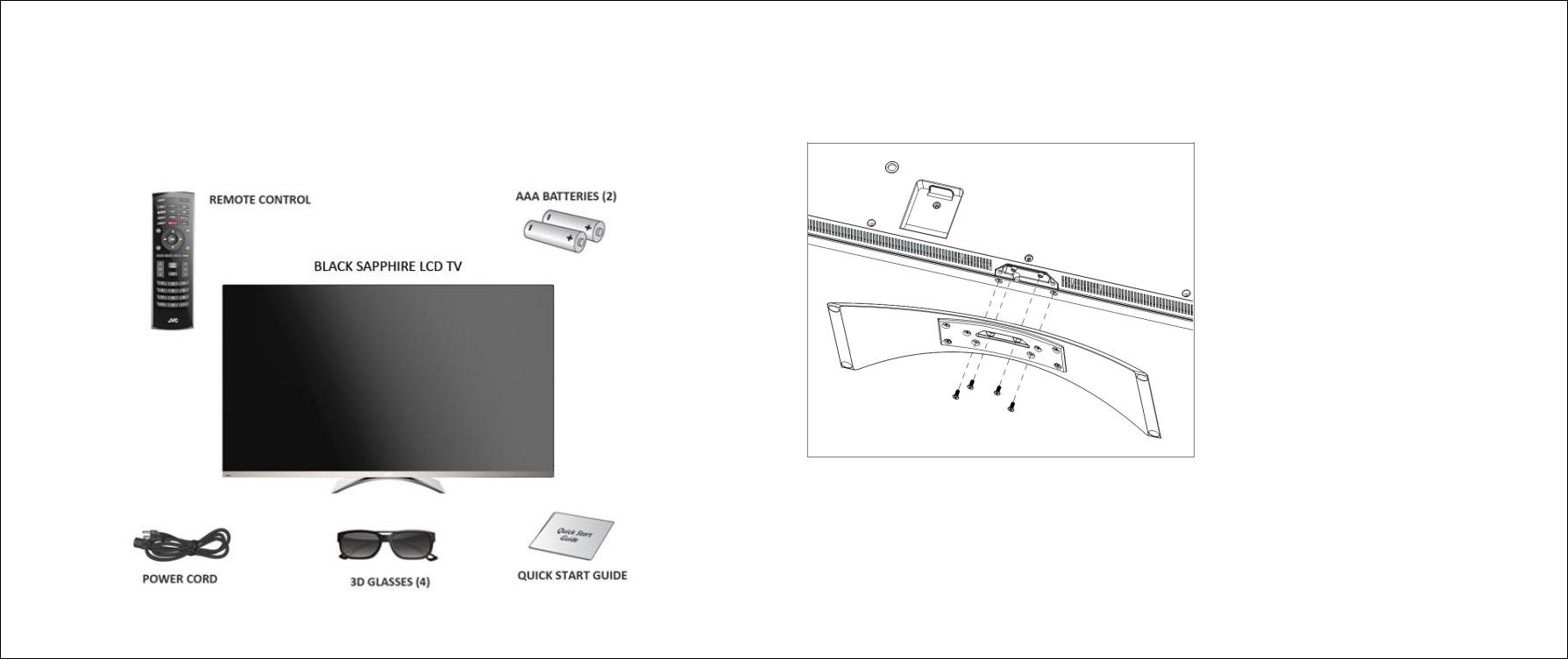
Setting Up The TV
Package Contents |
Attaching the Stand |
Your JVC Black Sapphire HDTV is shipped with the items shown below:
Keep the protective bag on TV and place them on a flat surface.
Attach stand to TV. Fasten the four screws provided.
Carefully lift TV up
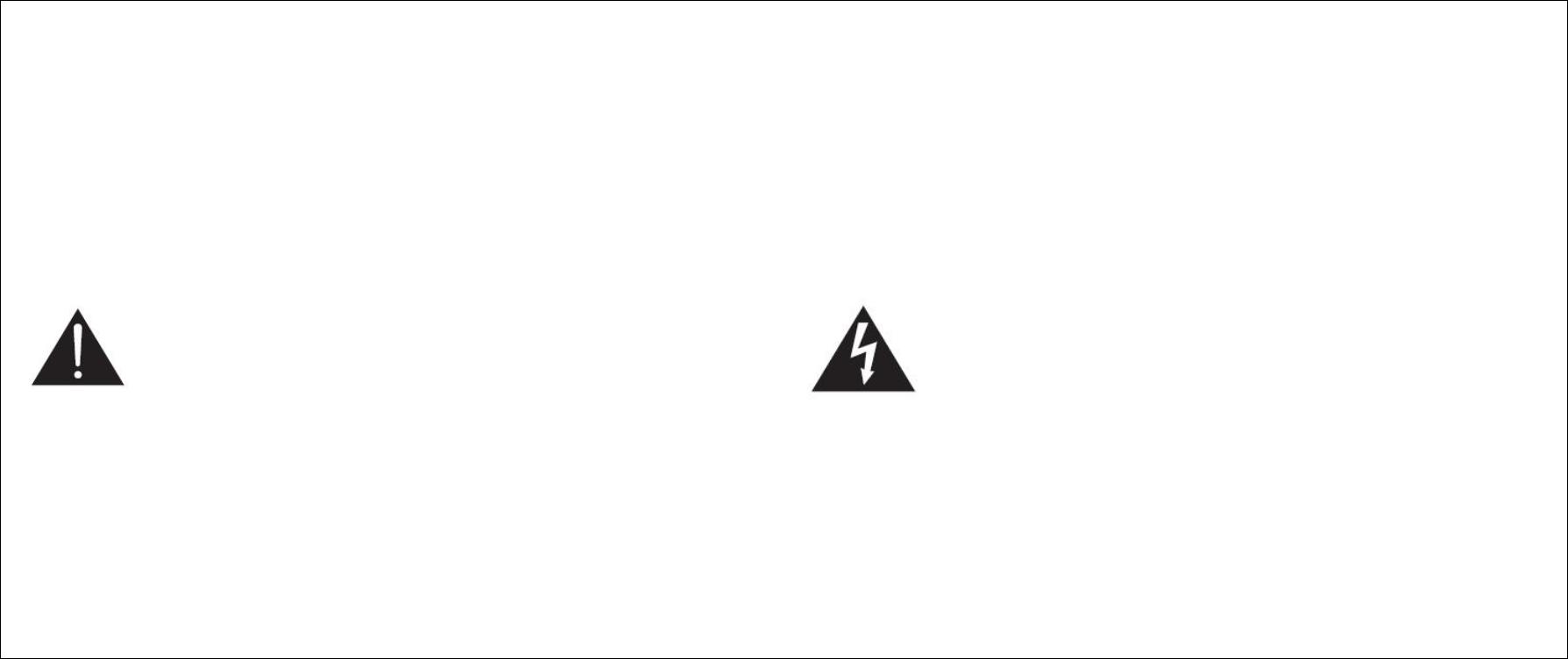
Setting Up The TV
Removing the Stand
When television needs to be transported, remove TV Stand and pack TV back in its shipping box. To remove TV Stand, remove screws securing stand to rear of television.
Wall Mounting
For product protection and safety reasons, JVC strongly recommends contacting a professional installer or technician for assistance with the installation of the wall mount and with the setup of your TV. JVC will not be held responsible for any damage to the product or injury to yourself and others should you decide to install the wall mount and TV without the assistance of a professional installer or technician.
Installing Wall Mount
A wall mount kit (not included with TV) allows you to mount the TV onto a wall. For the proper and safe installation of a wall mount, follow the detailed instructions included in the wall mount kit.
Refer to the specification section for the right wall mount size
Do not install your TV to the wall mount while the TV is turned on. It can result in personal injury due to electric shock.
A minimum of two people should be used when moving TV, and when installing TV onto a wall mount.

Setting Up The TV
1Turn off your TV and disconnect all cables.
2Carefully place the TV face down on a flat, clean, and padded surface. If available, put TV cover or protective sheet onto the TV before laying the TV down on flat surface.
3Using a cross-tip screwdriver, remove four screws securing TV stand to rear of TV. Remove TV stand.
4Follow instructions in wall mount kit and install wall mount. Install TV onto wall mount in accordance with wall mount kit instructions.
NOTE: Wall mount screw hole pattern on rear of this model is VESA
400 x 400mm, with M6 screws
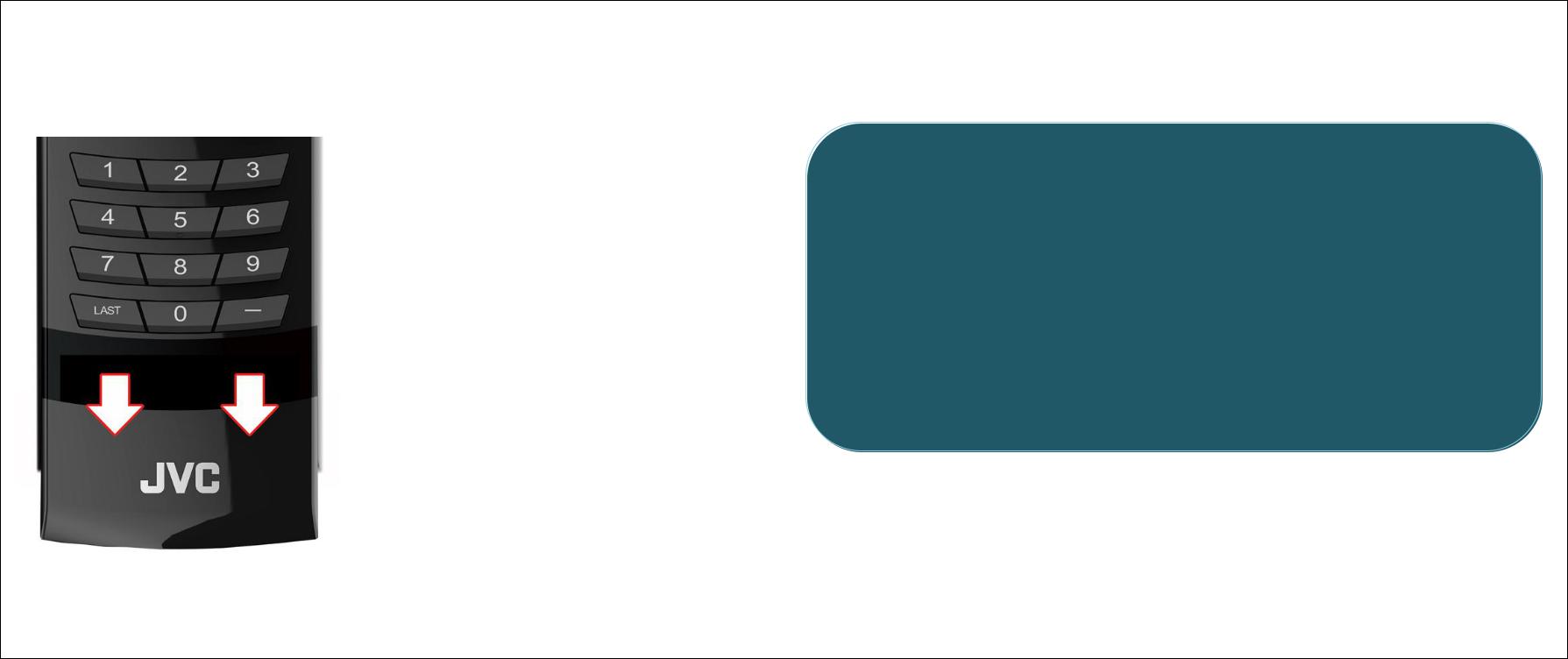
Setting Up The TV
Install Batteries Into Remote Control
To open the battery compartment, press down on top end of cover and then slide cover down.
Insert two AAA batteries into battery compartment. Observe correct polarity.
Battery Precautions:
Be sure to follow the correct polarity. Incorrect installation may cause battery leakage or damage to the remote control.
Always replace batteries in pairs; never combine a used battery with a new one.
Do not use different battery types together (e.g. Alkaline and Carbon-zinc).
If remote control will not be used for an extended period of time, remove batteries to prevent battery leakage.
Insert cover and slide up into place.
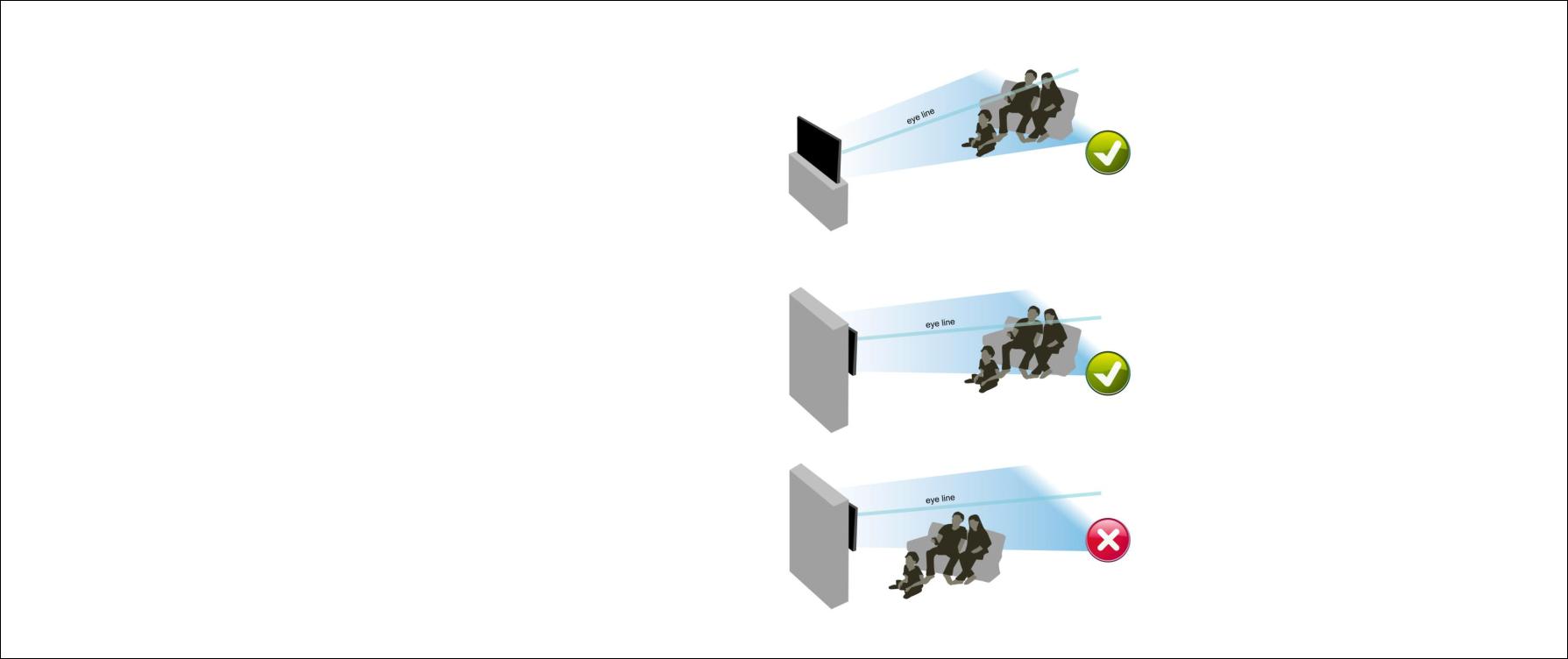
TV Placement For Best 3D Experience
Best 3D Viewing Effect
View the TV head-on, and place TV around 7 to 10 feet away from the audience. The best viewing distance is about 9 feet from the screen.
Make sure the center of TV is aligned to audiences’ line of sight
Things To Prevent
Weakened 3D effects may be caused by:
Viewing TV at an angle
Viewing the TV too close, or too far away
TV is not aligned to audiences’ line of sight
TV placed on TV stand and aligned to audiences’ eye level
Use wall mount hardware with tilt capability. TV is tilted down aligning to audiences’ eye line
Weakened 3D effects
Viewing TV at an angle
Viewing TV too close, or too far away
TV is not aligned to audiences’ line of sight
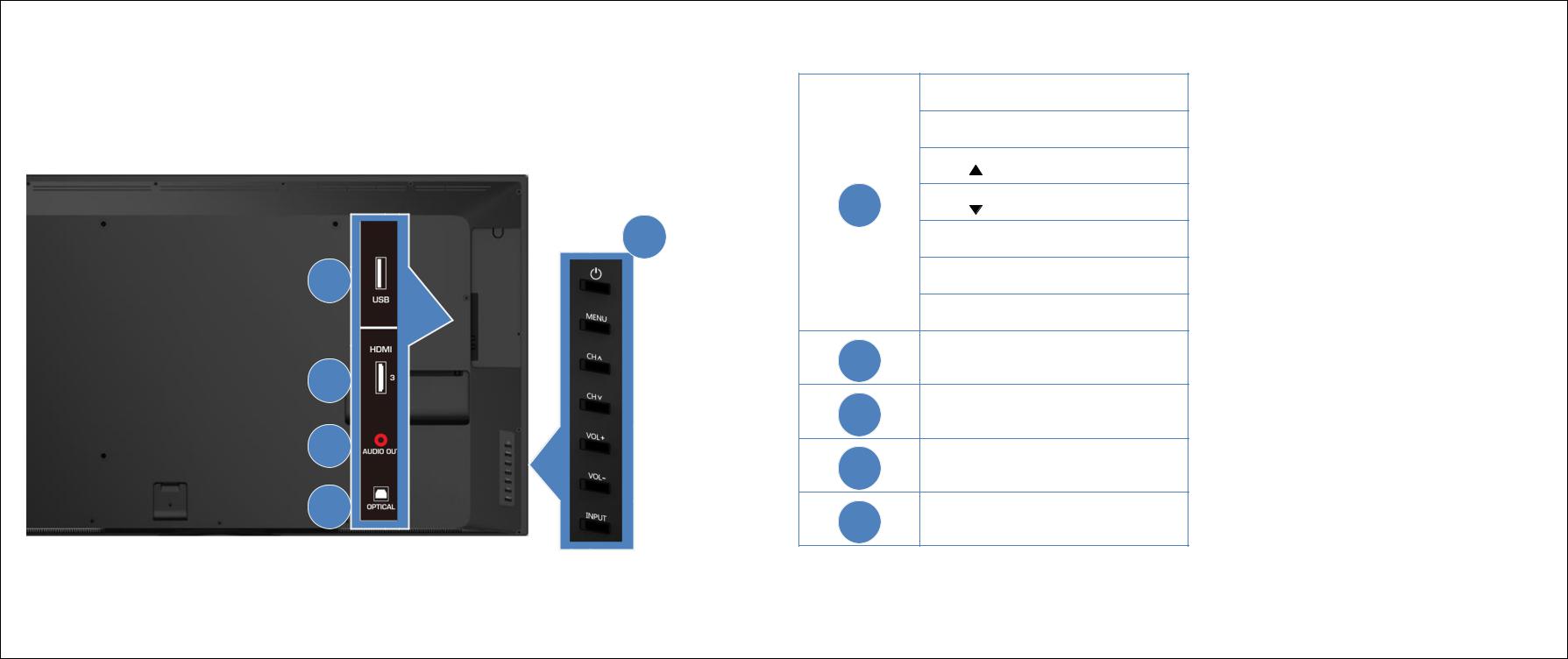
Parts and Functions - TV
Side View
|
Power Button |
|
|
MENU Button |
|
|
CH |
Button |
1 |
CH |
Button |
1 |
VOL+ Button |
|
2 |
VOL- Button |
|
|
INPUT Button |
|
2 |
USB Port |
|
3 |
|
|
3 |
HDMI -3 Port |
|
4 |
Audio Out (headphone) |
|
4 |
||
5 |
Optical Audio Out |
|
5 |
||
